Jinzhuo Wang
DoctorRAG: Medical RAG Fusing Knowledge with Patient Analogy through Textual Gradients
May 26, 2025Abstract:Existing medical RAG systems mainly leverage knowledge from medical knowledge bases, neglecting the crucial role of experiential knowledge derived from similar patient cases -- a key component of human clinical reasoning. To bridge this gap, we propose DoctorRAG, a RAG framework that emulates doctor-like reasoning by integrating both explicit clinical knowledge and implicit case-based experience. DoctorRAG enhances retrieval precision by first allocating conceptual tags for queries and knowledge sources, together with a hybrid retrieval mechanism from both relevant knowledge and patient. In addition, a Med-TextGrad module using multi-agent textual gradients is integrated to ensure that the final output adheres to the retrieved knowledge and patient query. Comprehensive experiments on multilingual, multitask datasets demonstrate that DoctorRAG significantly outperforms strong baseline RAG models and gains improvements from iterative refinements. Our approach generates more accurate, relevant, and comprehensive responses, taking a step towards more doctor-like medical reasoning systems.
Any-to-Any Learning in Computational Pathology via Triplet Multimodal Pretraining
May 19, 2025Abstract:Recent advances in computational pathology and artificial intelligence have significantly enhanced the utilization of gigapixel whole-slide images and and additional modalities (e.g., genomics) for pathological diagnosis. Although deep learning has demonstrated strong potential in pathology, several key challenges persist: (1) fusing heterogeneous data types requires sophisticated strategies beyond simple concatenation due to high computational costs; (2) common scenarios of missing modalities necessitate flexible strategies that allow the model to learn robustly in the absence of certain modalities; (3) the downstream tasks in CPath are diverse, ranging from unimodal to multimodal, cnecessitating a unified model capable of handling all modalities. To address these challenges, we propose ALTER, an any-to-any tri-modal pretraining framework that integrates WSIs, genomics, and pathology reports. The term "any" emphasizes ALTER's modality-adaptive design, enabling flexible pretraining with any subset of modalities, and its capacity to learn robust, cross-modal representations beyond WSI-centric approaches. We evaluate ALTER across extensive clinical tasks including survival prediction, cancer subtyping, gene mutation prediction, and report generation, achieving superior or comparable performance to state-of-the-art baselines.
Comprehensive Manuscript Assessment with Text Summarization Using 69707 articles
Mar 26, 2025Abstract:Rapid and efficient assessment of the future impact of research articles is a significant concern for both authors and reviewers. The most common standard for measuring the impact of academic papers is the number of citations. In recent years, numerous efforts have been undertaken to predict citation counts within various citation windows. However, most of these studies focus solely on a specific academic field or require early citation counts for prediction, rendering them impractical for the early-stage evaluation of papers. In this work, we harness Scopus to curate a significantly comprehensive and large-scale dataset of information from 69707 scientific articles sourced from 99 journals spanning multiple disciplines. We propose a deep learning methodology for the impact-based classification tasks, which leverages semantic features extracted from the manuscripts and paper metadata. To summarize the semantic features, such as titles and abstracts, we employ a Transformer-based language model to encode semantic features and design a text fusion layer to capture shared information between titles and abstracts. We specifically focus on the following impact-based prediction tasks using information of scientific manuscripts in pre-publication stage: (1) The impact of journals in which the manuscripts will be published. (2) The future impact of manuscripts themselves. Extensive experiments on our datasets demonstrate the superiority of our proposed model for impact-based prediction tasks. We also demonstrate potentials in generating manuscript's feedback and improvement suggestions.
KARMA: Leveraging Multi-Agent LLMs for Automated Knowledge Graph Enrichment
Feb 10, 2025
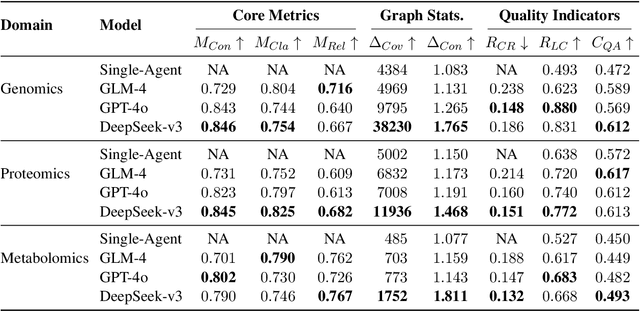
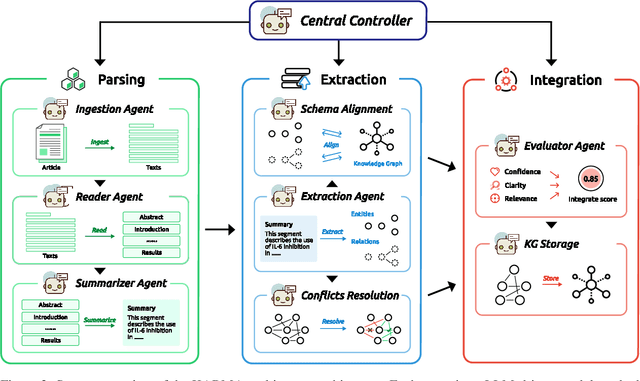
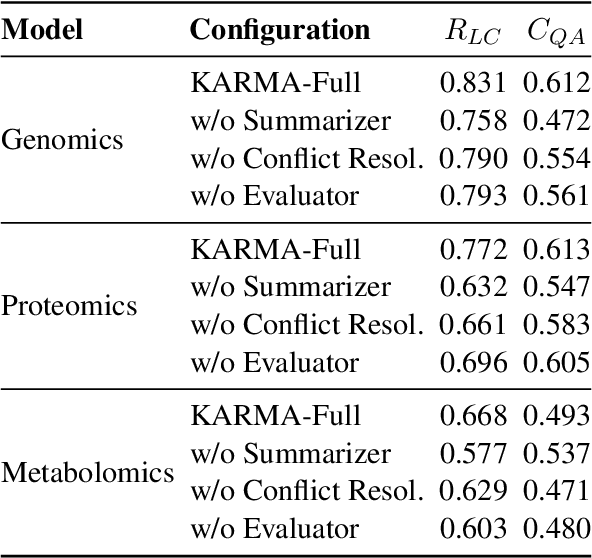
Abstract:Maintaining comprehensive and up-to-date knowledge graphs (KGs) is critical for modern AI systems, but manual curation struggles to scale with the rapid growth of scientific literature. This paper presents KARMA, a novel framework employing multi-agent large language models (LLMs) to automate KG enrichment through structured analysis of unstructured text. Our approach employs nine collaborative agents, spanning entity discovery, relation extraction, schema alignment, and conflict resolution that iteratively parse documents, verify extracted knowledge, and integrate it into existing graph structures while adhering to domain-specific schema. Experiments on 1,200 PubMed articles from three different domains demonstrate the effectiveness of KARMA in knowledge graph enrichment, with the identification of up to 38,230 new entities while achieving 83.1\% LLM-verified correctness and reducing conflict edges by 18.6\% through multi-layer assessments.
Context Matters: Query-aware Dynamic Long Sequence Modeling of Gigapixel Images
Jan 31, 2025Abstract:Whole slide image (WSI) analysis presents significant computational challenges due to the massive number of patches in gigapixel images. While transformer architectures excel at modeling long-range correlations through self-attention, their quadratic computational complexity makes them impractical for computational pathology applications. Existing solutions like local-global or linear self-attention reduce computational costs but compromise the strong modeling capabilities of full self-attention. In this work, we propose Querent, i.e., the query-aware long contextual dynamic modeling framework, which maintains the expressive power of full self-attention while achieving practical efficiency. Our method adaptively predicts which surrounding regions are most relevant for each patch, enabling focused yet unrestricted attention computation only with potentially important contexts. By using efficient region-wise metadata computation and importance estimation, our approach dramatically reduces computational overhead while preserving global perception to model fine-grained patch correlations. Through comprehensive experiments on biomarker prediction, gene mutation prediction, cancer subtyping, and survival analysis across over 10 WSI datasets, our method demonstrates superior performance compared to the state-of-the-art approaches. Code will be made available at https://github.com/dddavid4real/Querent.
Biomedical Knowledge Graph: A Survey of Domains, Tasks, and Real-World Applications
Jan 20, 2025



Abstract:Biomedical knowledge graphs (BKGs) have emerged as powerful tools for organizing and leveraging the vast and complex data found across the biomedical field. Yet, current reviews of BKGs often limit their scope to specific domains or methods, overlooking the broader landscape and the rapid technological progress reshaping it. In this survey, we address this gap by offering a systematic review of BKGs from three core perspectives: domains, tasks, and applications. We begin by examining how BKGs are constructed from diverse data sources, including molecular interactions, pharmacological datasets, and clinical records. Next, we discuss the essential tasks enabled by BKGs, focusing on knowledge management, retrieval, reasoning, and interpretation. Finally, we highlight real-world applications in precision medicine, drug discovery, and scientific research, illustrating the translational impact of BKGs across multiple sectors. By synthesizing these perspectives into a unified framework, this survey not only clarifies the current state of BKG research but also establishes a foundation for future exploration, enabling both innovative methodological advances and practical implementations.
Molecule-dynamic-based Aging Clock and Aging Roadmap Forecast with Sundial
Jan 04, 2025

Abstract:Addressing the unavoidable bias inherent in supervised aging clocks, we introduce Sundial, a novel framework that models molecular dynamics through a diffusion field, capturing both the population-level aging process and the individual-level relative aging order. Sundial enables unbiasedestimation of biological age and the forecast of aging roadmap. Fasteraging individuals from Sundial exhibit a higher disease risk compared to those identified from supervised aging clocks. This framework opens new avenues for exploring key topics, including age- and sex-specific aging dynamics and faster yet healthy aging paths.
FOCUS: Knowledge-enhanced Adaptive Visual Compression for Few-shot Whole Slide Image Classification
Nov 22, 2024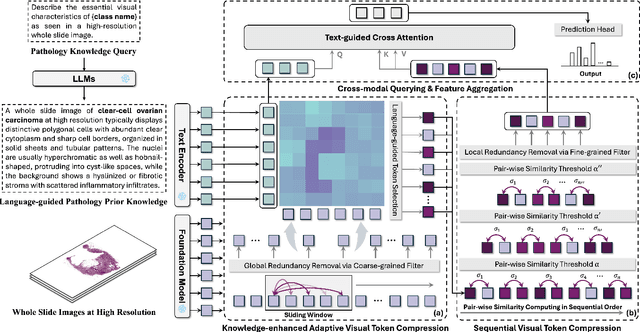
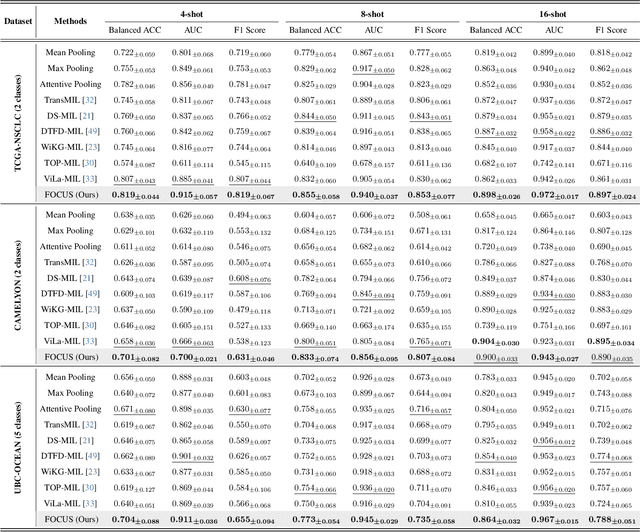
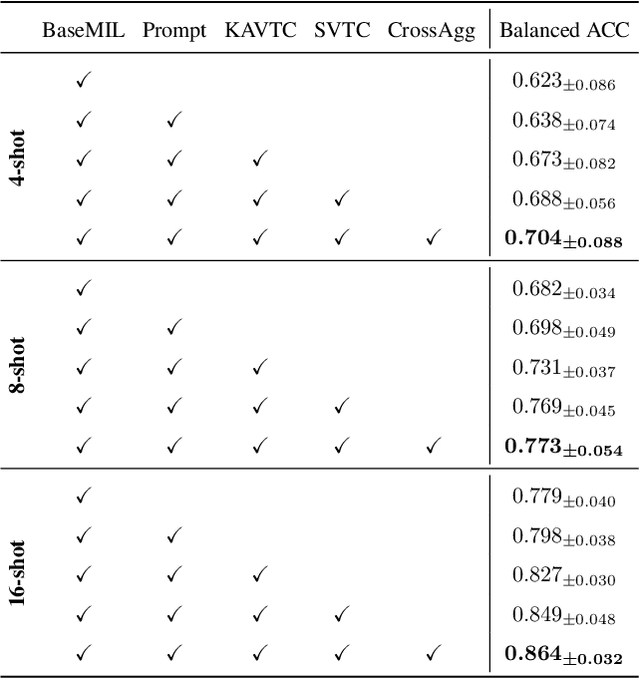
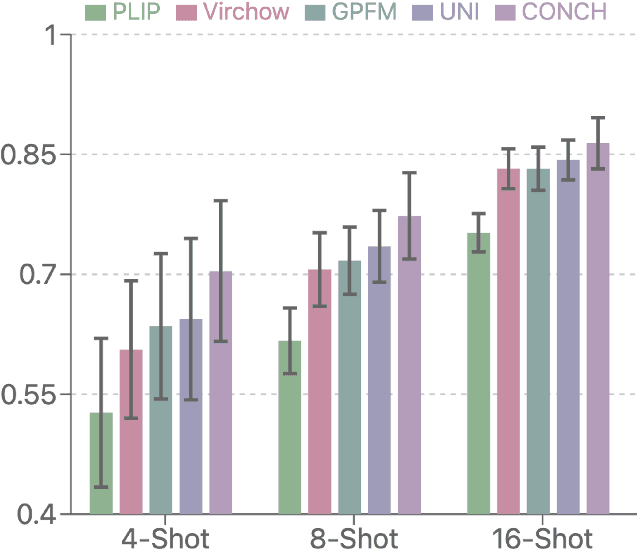
Abstract:Few-shot learning presents a critical solution for cancer diagnosis in computational pathology (CPath), addressing fundamental limitations in data availability, particularly the scarcity of expert annotations and patient privacy constraints. A key challenge in this paradigm stems from the inherent disparity between the limited training set of whole slide images (WSIs) and the enormous number of contained patches, where a significant portion of these patches lacks diagnostically relevant information, potentially diluting the model's ability to learn and focus on critical diagnostic features. While recent works attempt to address this by incorporating additional knowledge, several crucial gaps hinder further progress: (1) despite the emergence of powerful pathology foundation models (FMs), their potential remains largely untapped, with most approaches limiting their use to basic feature extraction; (2) current language guidance mechanisms attempt to align text prompts with vast numbers of WSI patches all at once, struggling to leverage rich pathological semantic information. To this end, we introduce the knowledge-enhanced adaptive visual compression framework, dubbed FOCUS, which uniquely combines pathology FMs with language prior knowledge to enable a focused analysis of diagnostically relevant regions by prioritizing discriminative WSI patches. Our approach implements a progressive three-stage compression strategy: we first leverage FMs for global visual redundancy elimination, and integrate compressed features with language prompts for semantic relevance assessment, then perform neighbor-aware visual token filtering while preserving spatial coherence. Extensive experiments on pathological datasets spanning breast, lung, and ovarian cancers demonstrate its superior performance in few-shot pathology diagnosis. Code will be made available at https://github.com/dddavid4real/FOCUS.
Automated Movement Detection with Dirichlet Process Mixture Models and Electromyography
Feb 15, 2023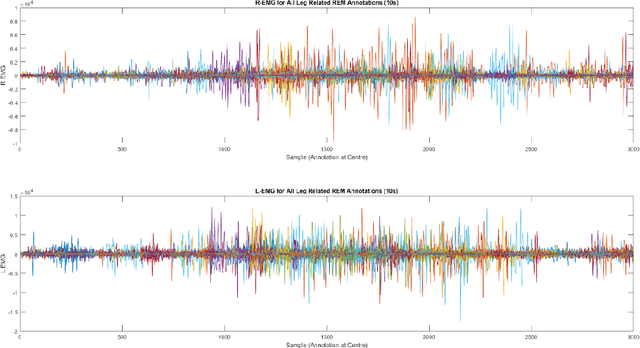
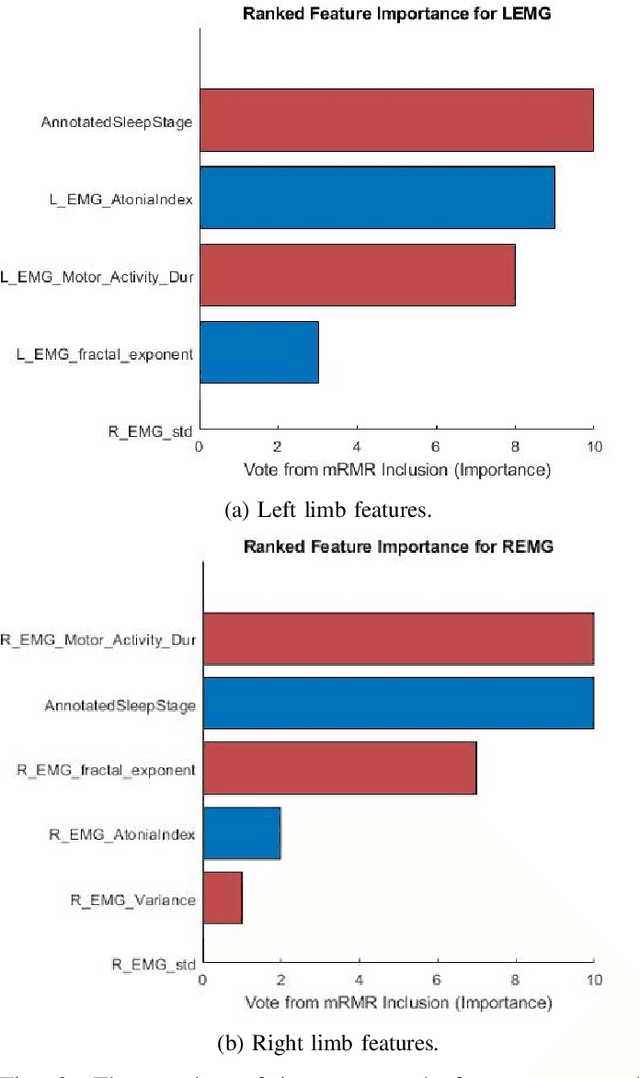
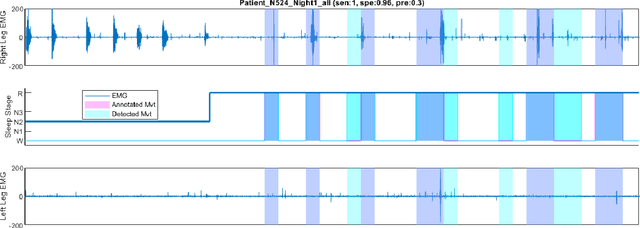

Abstract:Numerous sleep disorders are characterised by movement during sleep, these include rapid-eye movement sleep behaviour disorder (RBD) and periodic limb movement disorder. The process of diagnosing movement related sleep disorders requires laborious and time-consuming visual analysis of sleep recordings. This process involves sleep clinicians visually inspecting electromyogram (EMG) signals to identify abnormal movements. The distribution of characteristics that represent movement can be diverse and varied, ranging from brief moments of tensing to violent outbursts. This study proposes a framework for automated limb-movement detection by fusing data from two EMG sensors (from the left and right limb) through a Dirichlet process mixture model. Several features are extracted from 10 second mini-epochs, where each mini-epoch has been classified as 'leg-movement' or 'no leg-movement' based on annotations of movement from sleep clinicians. The distributions of the features from each category can be estimated accurately using Gaussian mixture models with the Dirichlet process as a prior. The available dataset includes 36 participants that have all been diagnosed with RBD. The performance of this framework was evaluated by a 10-fold cross validation scheme (participant independent). The study was compared to a random forest model and outperformed it with a mean accuracy, sensitivity, and specificity of 94\%, 48\%, and 95\%, respectively. These results demonstrate the ability of this framework to automate the detection of limb movement for the potential application of assisting clinical diagnosis and decision-making.
More Information Supervised Probabilistic Deep Face Embedding Learning
Jun 11, 2020



Abstract:Researches using margin based comparison loss demonstrate the effectiveness of penalizing the distance between face feature and their corresponding class centers. Despite their popularity and excellent performance, they do not explicitly encourage the generic embedding learning for an open set recognition problem. In this paper, we analyse margin based softmax loss in probability view. With this perspective, we propose two general principles: 1) monotonic decreasing and 2) margin probability penalty, for designing new margin loss functions. Unlike methods optimized with single comparison metric, we provide a new perspective to treat open set face recognition as a problem of information transmission. And the generalization capability for face embedding is gained with more clean information. An auto-encoder architecture called Linear-Auto-TS-Encoder(LATSE) is proposed to corroborate this finding. Extensive experiments on several benchmarks demonstrate that LATSE help face embedding to gain more generalization capability and it boosted the single model performance with open training dataset to more than $99\%$ on MegaFace test.
 Add to Chrome
Add to Chrome Add to Firefox
Add to Firefox Add to Edge
Add to Edge